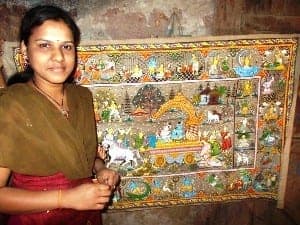By: Ujjivan
Pair a dream with a microloan and you may find a path to a better life.

When you take a right turn at the Nakhra junction on the busy Bhubaneshwar-Cuttack highway, and travel another two kilometers, you will come across Phulnakhra, a nondescript town about 20 kilometers from Bhubaneshwar, the capital of the Indian state of Odisha. It is in towns like these that India’s traditional and world-renowned arts and handicrafts were born centuries ago, such as pattachitra, a traditional painting style based on Hindu mythology that the state of Odisha is known for. These artists, known as chitrakaras, use only natural colors created in the traditional way: grinding, boiling and filtering vegetables and minerals to produce the brilliance in hue associated with the pattachitra.
As tastes in art have moved away from traditional handicrafts, many traditional artisans are giving up their craft to pursue more lucrative professions. So it comes as a bit of a surprise to find Kalpana Moharana, a 24-year old Phulnakhra native who wants to develop her pattachitra skills further and expand her business.
Kalpana didn’t set out to be chitrakara. She has headed for the educated class, but her family’s financial reality proved a big barrier: their monthly household income of Rs.6000 (USD 93) is often barely enough to support their family of four. Her father and brother earn this income through furniture work while her mother and sister-in-law run the household. Kalpana is the youngest in the household and so her freedom was often restricted by her family. But they were supportive of her education—in fact, she completed the matriculation exam to enter university in 2002. However, given her family’s difficult financial circumstances, she had to drop out of school shortly thereafter. Needless to say, Kalpana was devastated.
While she was helping out in the household and doing odd jobs to support the family income, Kalpana learned about pattachitra from traditional expert artisans at Kendupitha, a nearby village. Gradually, she got more interested in the work and started working with these artisans more and more. She picked up the skills quickly and felt that she found a renewed purpose to her life. Within a year of her training, Kalpana started working on her own pattachitra designs from home.
The biggest expenses in pattachitra creation are the canvas bundles and the natural colors. For Kalpana, these average to about Rs.100 (USD 1.56)for each pattachitra. She took a loan from Ujjivan (one of their first clients in the area) in order to purchase the canvas in bulk to get better rates. Today, she has a loan of Rs.12,000 (USD 187.23) in her third year with Ujjivan and her business is thriving: major retail outlets in tourist cities such as Bhubaneshwar have been placing orders for Kalpana’s pattachitras.
Today, Kalpana earns about Rs.250-300 (USD 3.90-4.68) for each pattachitra she makes. She earns around Rs.3000 (USD 46.81) per month from the sales of her pattachitras, half of what her father and brother used to earn! She is able to support herself and her family, and is reviving an almost-lost Indian tradition at the same time. Kalpana’s story is an inspiring reminder of how despite having one’s dreams taken away, you can still seize opportunity and, with the help of an organization like Ujjivan, make another kind of dream come true.
*Rupee to dollar amounts were converted using June 12, 2015 foreign exchange rates
JOIN US
Celebrate 40 years of Women’s World Banking
April 4, 2019
IAC Building, New York City
Purchase Tickets



